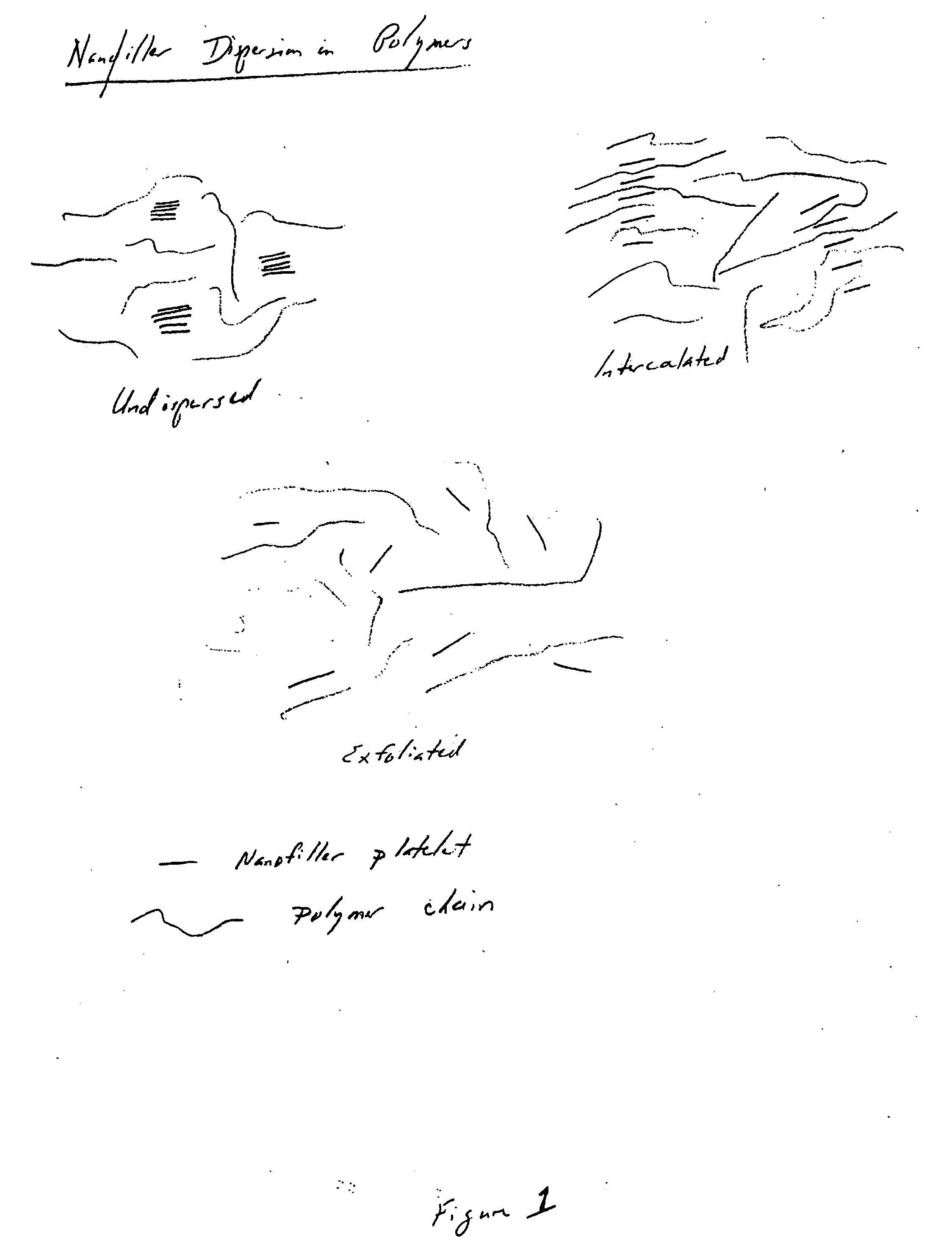Golf balls incorporating nanofillers
a technology of nanofillers and golf balls, applied in the field of golf ball compositions, can solve the problems of poor ball control, short distance, poor durability, and low spin rate of two-piece balls
- Summary
- Abstract
- Description
- Claims
- Application Information
AI Technical Summary
Benefits of technology
Problems solved by technology
Method used
Image
Examples
example 1
1) Example 1
Use of nanocomposite materials was tested in golf ball covers. Test golf balls were prepared in which the covers comprised either 10% or 20% by weight of nanocomposite material. The particular nanocomposite material used was M1030D, a polyamide 6-based nanocomposite material manufactured by Unitika, Limited. of Tokyo, Japan. This nanocomposite material is prepared by dispersion of treated nanometer-scale phyllosilicate in the base monomer prior to polymerization. This nanocomposite material has low specific gravity, high modulus and high strength, and therefore it is particularly suitable for use in golf ball cover compositions. Other comparable nanocomposite materials, such as those discussed above, also could be used, depending upon the particular properties to be imparted to the resulting golf ball.
The test balls each had a core having a PGA compression of 70. Over each core was placed a mantle layer having a hardness of 37 on the Shore D scale, a flexural modulus ...
example 2
2) Example 2
The use of nanofillers in ionomers was tested in golf ball covers. The test balls each had a 1.58″ diameter core having a PGA compression of 70. Over each core was injection molded a cover layer comprising ionomer filled with varying levels of Cloisite NA nanofiller from Southern Clay Products (Gonzales, Texas). The ionomer composition was a blend of two high acid copolymer ionomers (8140 and 9120) and one terpolymer ionomer (8320) from the commercial Surlyn product line of du Pont; Surlyn 8140 and 9120 were 25% of the ionomer blend each with Surlyn 8320 being 50%. A 50% color concentrate in a high acid copolymer ionomer was also used. The ionomeric cover compositions incorporating the nanofiller were manufactured using conventional twin-screw compounding techniques. The particular cover compositions tested are provided below in Table 3.
TABLE 3Surlyn BlendSurlyn Color ConcentrateMaterial #(pph)(pph)Cloisite NA (pph)110050210051310054410057
Testing
The materials were ...
example 3
The use of nanofillers in ionomer / TPE blends was tested in golf ball covers. The test balls each had a 1.58″ diameter core having a PGA compression of 70. Over each core was injection molded a cover layer comprising ionomer / TPE blend filled with varying levels of Cloisite NA nanofiller from Southern Clay Products (Gonzales, Tex.). The ionomer was a high acid copolymer ionomer (Surlyn 6120) from the commercial Surlyn product line of du Pont and the TPE was Kuraray's Septon HG-252 hydroxy-terminated styrene / ethylene-propylene / styrene block copolymer. The ionomer:TPE ratio was 60:40. A 50% color concentrate in a high acid copolymer ionomer was also used. Additionally, Atofina's Lotader AX8920 and Rohm & Haas' Paraloid EXL-2691A were added to the blend. The cover compositions incorporating the nanofiller were manufactured using conventional twin-screw compounding techniques. The particular cover compositions tested are provided below in Table 6.
TABLE 6Surlyn / TPESurlyn ColorCloisiteLo...
PUM
| Property | Measurement | Unit |
|---|---|---|
| thickness | aaaaa | aaaaa |
| thickness | aaaaa | aaaaa |
| diameter | aaaaa | aaaaa |
Abstract
Description
Claims
Application Information
 Login to View More
Login to View More - R&D
- Intellectual Property
- Life Sciences
- Materials
- Tech Scout
- Unparalleled Data Quality
- Higher Quality Content
- 60% Fewer Hallucinations
Browse by: Latest US Patents, China's latest patents, Technical Efficacy Thesaurus, Application Domain, Technology Topic, Popular Technical Reports.
© 2025 PatSnap. All rights reserved.Legal|Privacy policy|Modern Slavery Act Transparency Statement|Sitemap|About US| Contact US: help@patsnap.com


